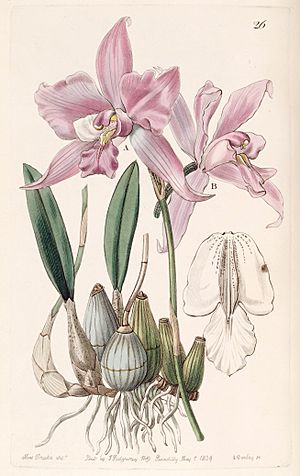Laelia furfuracea facts for kids
Quick facts for kids Laelia furfuracea |
|
|---|---|
 |
|
| Scientific classification | |
| Genus: |
Laelia
|
| Species: |
furfuracea
|
| Synonyms | |
Laelia furfuracea is a beautiful type of orchid that grows naturally only in Mexico. It is found mostly in the state of Oaxaca. This special plant is known for its lovely flowers and unique features. It is a very specific kind of orchid, meaning it is endemic to this region. This makes it a unique part of Mexico's plant life.
Contents
What is Laelia furfuracea?
Laelia furfuracea is a specific kind of orchid. Orchids are a huge family of flowering plants. They are famous for their colorful and often strangely shaped flowers. This particular orchid is part of the Laelia genus. The name furfuracea comes from a Latin word. It describes a powdery or scaly look on some parts of the plant.
Where Does This Orchid Grow?
This special orchid grows only in Mexico. Its natural home is the state of Oaxaca. Oaxaca is in southern Mexico. It has many different types of environments. Laelia furfuracea often grows in rocky areas. It can be found on cliffs or among rocks. It prefers places with good drainage. This means water does not stay around its roots for too long.
What Does Laelia furfuracea Look Like?
Laelia furfuracea has lovely flowers. They usually bloom in the late fall or early winter. The flowers can be various shades of pink or purple. They often have a darker lip, which is the bottom petal. This lip might have interesting patterns or veins. The plant itself grows from a pseudobulb. This is a swollen stem that stores water and nutrients. It helps the orchid survive dry periods.
The Orchid's Leaves and Stems
The leaves of Laelia furfuracea are usually long and narrow. They are a green color. These leaves grow from the top of the pseudobulbs. The flower stems grow tall. They hold one or more beautiful flowers. Each flower can be several centimeters wide. This makes them quite noticeable.
The Life Cycle of Laelia furfuracea
Like all plants, Laelia furfuracea goes through a life cycle. It starts from a tiny seed. Orchids produce many tiny seeds. These seeds need special conditions to grow. They often need help from a certain type of fungus. This fungus helps the seed get nutrients.
How Orchids Reproduce
Orchids reproduce using their flowers. The flowers attract pollinators. These are often insects like bees or butterflies. The pollinators carry pollen from one flower to another. This process is called pollination. After successful pollination, the flower develops a seed pod. This pod contains many tiny seeds. When the pod ripens, it splits open. The seeds are then carried by the wind. They can travel far away.
Growing Conditions for This Orchid
Laelia furfuracea needs specific conditions to thrive. It likes bright light. However, it needs some protection from the strongest sun. It also prefers a cool, dry winter rest period. This rest helps the plant prepare for new growth and flowering. During its growing season, it needs more water. But it still needs good air circulation around its roots. This prevents rot.
Why is Laelia furfuracea Important?
This orchid is important for several reasons. It is a part of Mexico's natural biodiversity. Biodiversity means all the different kinds of life in an area. Each species plays a role in its ecosystem. Laelia furfuracea adds to the beauty of its habitat. It also provides a home or food for some insects.
Conservation of Orchids
Many orchids, including some Laelia species, face threats. Their habitats can be destroyed. This happens because of human activities. Collecting wild orchids can also harm their populations. Because Laelia furfuracea is endemic to a small area, it is especially important to protect it. Conservation efforts help keep these unique plants safe. This ensures they can continue to grow in their natural homes for many years.
See also
 In Spanish: Laelia furfuracea para niños
In Spanish: Laelia furfuracea para niños

